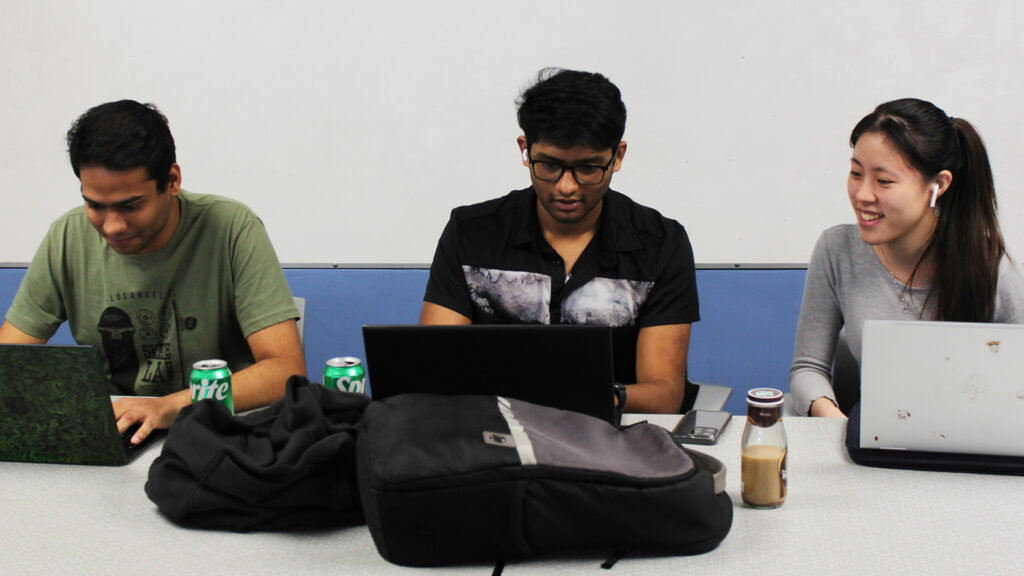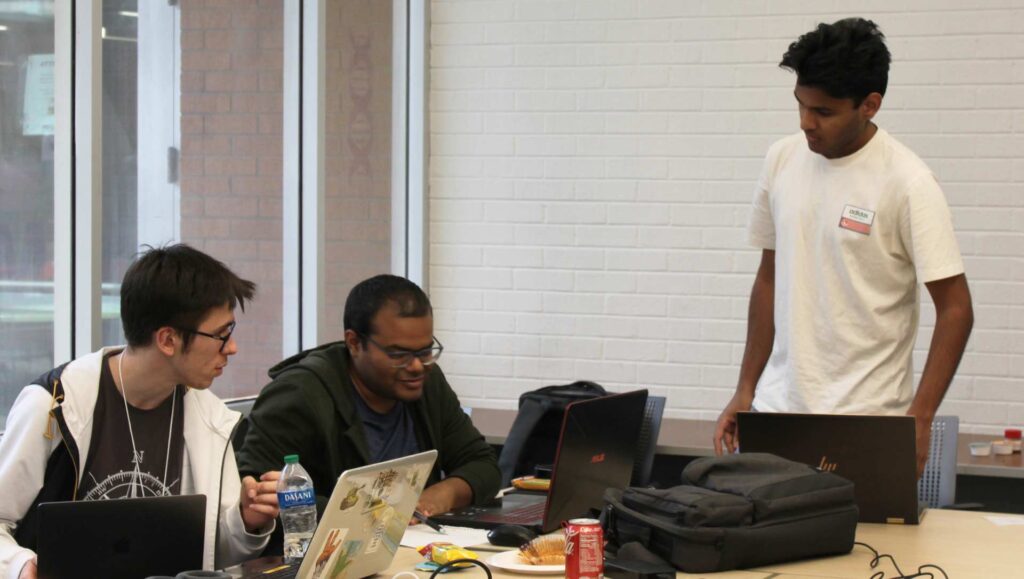
ASU engineering students DASSH to earn $42K in cash
Computer science and engineering students walk away with top honors at hackathon

It’s a dry heat.
In the summer in Phoenix, it is the thirty-first day of a heat wave that has brought record-breaking temperatures to the city. People seek refuge in air-conditioned buildings, creating an unsustainable demand for energy. The power grid fails. Hospitals fill up with patients suffering from heat stroke, but doctors require lights to effectively treat them. Food begins to spoil. Flights get grounded. Panic ensues.
This hypothetical scenario is an example of the cascade effect — when an unexpected event occurs and triggers a series of calamities.
Students in the School of Computing and Augmented Intelligence, part of the Ira A. Fulton Schools of Engineering at ASU, are not just studying these cascading events, they’re developing plans to prevent and manage such disasters.
The reward? Cold, hard cash.
At the Devils Invent DASSH Cascading Events hackathon, held on ASU’s Tempe campus from February 23 to 25, Fulton Schools computer science and engineering students tackled various cascading problems, winning first place in all categories and taking home more than $42,000 in cash from a total $50,000 prize pot.
At the event, 35 teams from universities across the nation, including Rutgers, Northeastern and the Stevens Institute of Technology, created solutions to one of three problem statements. Students were asked: how could we deal with an artificial intelligence-enabled cyber-attack on critical infrastructure? How might we handle an enemy attack that is exacerbated by a major heat wave? And finally, how would we recover from a large earthquake and tsunami in Northern California?
The event was sponsored by the Center for Accelerating Operational Efficiency, or CAOE, a nationwide consortium of 25 universities and partners led by ASU, and also a U.S. Department of Homeland Security Center of Excellence.
Students were free to take both hardware and software approaches. They were given access to Arduino kits, a pack of small, single-board computers used for simple robotics. Competitors could also use 3D printers, laptops and basic supplies, such as wood and cardboard, to build hardware prototypes. Teams created projects that were judged by a panel of industry experts, who assessed both the solutions and the presentation skills of the students.
“It’s almost got a Shark Tank element to it,” says Michael Machas, an assistant teaching professor in the Fulton Schools who served as a mentor at the event. “It’s important to create solutions to these problems, but you also have to convince people that your solution will work.”

ASU computer science students Aarav Jain, Sri Vijwal Reddy and Ivy Lo discuss how to prepare emergency response systems for a heat wave. Photographer: Kelly deVos/ASU
Real solutions for the real world
Team ATASA, an interdisciplinary group that included Fulton Schools computer science sophomores Anirudh Manjesh, Tamara Grujicic and Angel Le, along with mechanical engineering students Adithi Muruganandam and Sahana Sundaram, took home third place and $2,500 in prize money for their solution to the earthquake response problem.
The students proposed a four-phase earthquake response system using satellites and drones to feed critical information to disaster event managers and first responders. Their solution would use high-tech hardware to ensure that resources such as food, water and medical supplies get to those who need it most.
“The important thing is that all this technology already exists,” Sundaram says. “This is a totally implementable solution.”
The idea that their work could be deployed in the real world was top-of-mind for the contestants.
A team led by Sri Vijwal Reddy, a sophomore, proposed a solution to the heat wave challenge. His group of three computer science students, which also included Aarav Jain, a junior, and Ivy Lo, a sophomore, sought to create a public awareness application that would take in data from the U.S. Environmental Protection Agency, or EPA, while gathering feedback from the user, such as their location.
The application would then provide helpful alerts, such as advising users when area hospitals became full and direct them to alternative locations for treatment.
“We’re taking data that the EPA already gathers,” Vijwal Reddy says. “They have everything. Our solution would ensure that it’s all in one place and easy to access.”

Computer science students hard at work tackling one of three problem statements and preparing to present their solutions to industry experts. Photographer: Kelly deVos/ASU
Industry experts praise interdisciplinary approach
In addition to practical experience, students also gained the opportunity to connect with leadership in key career sectors for their majors.
Robert Putnam, chief production scientist at Los Alamos National Laboratory’s plutonium facility, observed the event as part of ongoing efforts to recruit students and fill the laboratory’s pipeline with top engineering talent.
“At Los Alamos, we’re tackling problems that have never been solved,” Putnam says. “We’re taking a robust, interdisciplinary approach as part of our mission to protect national security.”
He was impressed by what he saw at the event and appreciated the blend of soft skills and technical capabilities the students demonstrated.
“We need strong communicators and team members,” Putnam says.
Ross Maciejewski, who serves as director of both the School of Computing and Augmented Intelligence and CAOE, was proud of the compelling turnout from university students across the country and of ASU’s strong showing in the results.
“Of course, as center director, it’s highly important to ensure that there are widespread efforts to develop the skills needed to deal with cascading events. Seeing so many great teams from top universities means we are working hard to prepare the country for emergencies,” Maciejewski says. “But, as school director, it is particularly satisfying to see our own students do so well in the judging.”
With their winnings, some students hoped to save up for down payments for cars and houses. Others expected to apply their prize money toward school tuition.
Mantesh from Team ATASA planned to use the funds to spend the summer abroad. “I need the money,” he says with a laugh.
2024 DASSH Winners
Problem one: How could we deal with an artificial intelligence-enabled cyber-attack on critical infrastructure?
First place ($10,000 total prize)
ASU — Neutrinos
- Swapnil Kannojia
- Venkata Satya Chakri Yagnamurthy
- Preksha Nagesh
Second place ($5,000 total prize)
ASU — One Second Til Midnight
- Sameer Reza
- Yuki Ogawa
- Joshua Nguyen
Third place ($2,500 total prize)
Stevens Institute of Technology — Stevens Stargazers
- Daniel Kadyrov
- Christopher Francis
Problem two: How might we handle an enemy attack that is exacerbated by a major heat wave?
First place ($10,000 total prize)
ASU — Unstructured Infrastructure
- Anastasia Ivanova
- Dakota Edwards
- Virrajith Mallavarapu
- Gavin Russo
Second place ($5,000 total prize)
Northeastern University —Huskies
- Surya Sai Brahmendra Ramoju
- Sri Likhitha Anuganti
- John Yethi Rajulu Batthula
- Hari Chandana Kannuru
- Rohit Varma Mudundi
- Sahita Bonthu
Third place ($2,500 total prize)
Rutgers University and Northeastern University — Moder’s Sentinels
- Jonathan Bergeron
- Avin Laali
- Zhixiong Duan
- Shengyuan Feng
Problem three: How would we recover from a large earthquake and tsunami in Northern California?
First place ($10,000 total prize)
ASU — Caffeine Compilers
- Darshan Vipresh Sheth
- Deep Rodge
- Ayushi Rajshekhar
Second place ($5,000 total prize)
ASU — NKPS
- Sameer Bhagavatula
- Pranav Nadimpalli
- Nikhil Menghani
- Kasyap Rachuri
Third place ($2,500 total prize)
ASU — ATASA
- Anirudh Manjesh
- Adithi Muruganandam
- Sahana Sundaram
- Angel Le
- Tamara Grujicic



































